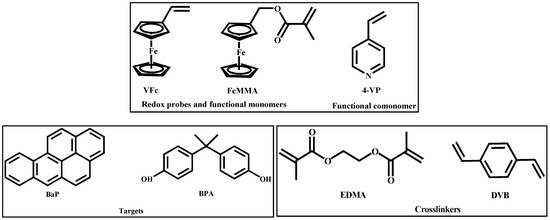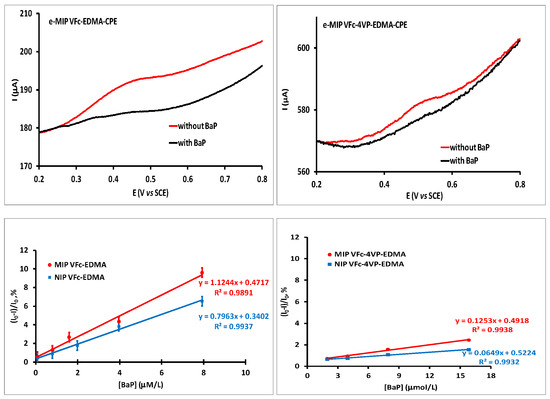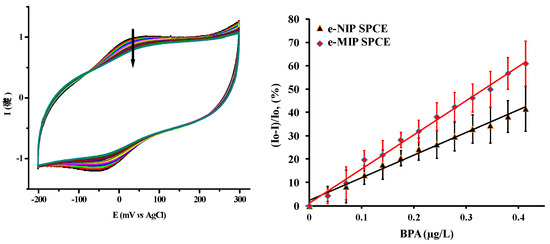Abstract
Electrochemical molecularly imprinted polymers (e-MIP) are MIP specially designed to detect aromatic organic molecules without redox properties. The detection is based on the electrochemical answer of a redox probe inserted inside the binding cavities of cross-linked MIPs. Microbeads of e-MIP were synthesized from vinylferrocene or ferrocenylmethyl methacrylate as functional monomer/redox probe with or without 4-vinylpyridine functional as co-monomer, benzo[a]pyrene or bisphenol A as the target and ethylene glycol dimethacrylate of divinylbenzene as cross-linker. After physico-chemical characterization, e-MIP microbeads were incorporated in a graphite paste to prepare modified electrode or screen-printed carbon electrodes (SPCE).
1. Introduction
Molecularly Imprinted Polymers (MIPs) are three-tridimensional polymers network prepared around a molecular template. After template releasing, MIPs have binding cavities which retain shape, size and orientation of the target molecule. MIPs can advantageously replace natural receptors in biosensor devices due to their simple synthesis, high stability and low cost [1]. We developed since a few years electrochemical molecularly imprinted polymers (e-MIP) by integration of a redox probe inside the binding cavities of cross-linked MIPs during their synthesis. By this way, the detection of the target molecule is based on the electrochemical answer of the redox probe [2]. This new concept was first established for the detection of benzo[a]pyrene with vinylferrocene used as redox probe and as functional monomer [3,4]. More recently, we have extended this strategy to the detection of Bisphenol A from ferrocenylmethyl methacrylate as functional redox tracer. In all cases, the detection is based on the π-π interactions between the aromatic rings of the target molecules and the aromatic cyclopentadienyl rings of ferrocene, thus leading to the modulation of ferrocene redox properties. These new e-MIP microbeads particles were incorporated in a graphite paste to prepare screen- printed carbon electrodes. A highly sensitivity for BPA in aqueous medium was obtained with a limit of detection of 0.06 nM [5]. Here, we present a resume of our research on electrochemical Molecularly Imprinted Polymers (e-MIPs).
2. Results
Microbeads of e-MIP and e-NIP (electrochemical Non-Imprinted Polymer) were prepared by precipitation polymerization with vinylferrocene (VFc) or ferrocenylmethyl methacrylate (FcMMA) as functional monomer and redox probe, with or without 4-vinylpyridine (4-VP) as co-functional monomer, ethylene glycol dimethacrylate (EDMA) or divinylbenzene (DVB) as the crosslinker and benzo[a]pyrene (BaP) or bisphenol A (BPA) as targets (Figure 1).

Figure 1.
Molecular structures of e-MIP components.
In all configurations, characterization of polymers by FTIR spectroscopy confirmed the presence of the ferrocene by its symmetric ring in plane vibration at 1003 cm-1 and ring-Fe vibration band at 484 cm-1. The correct leaching of BaP or BPA from e-MIPs was confirmed by the absence of any major characteristic band of these targets in the e-MIP spectrum and by the high similitude of e-MIPs and e-NIPs spectra. SEM pictures revealed spherical particles with average diameters from 0.22 µm for e- MIP-VFc-DVB [4] to 4.40 µm for the e-MIP-FcMMA-EDMA [5]. Adsorptions of targets were studied in aqueous medium by batch experiments after an equilibration time of 24 h. The binding studies revealed that the higher values are obtained with introduction of 4-VP and DVB. An increase adsorption capacity by a factor 6-8 due to an increase of π-π interactions between aromatic rings of targets and ferrocene was observed in the case of BaP target. However, a decrease of imprinting factor is also observed indicating an increase of the non specific adsorption.
For BaP detection, mixtures of carbon paste (CPE)/e-MIP-VFc-EDMA or e-NIP-VFc-EDMA (4:1, w/w) were prepared and put in a 5 mm diameter empty working electrode. After drying under vacuum, the carbon paste custom working electrode was polished and used in a classical three electrodes cell equipped with platinum as counter electrode and Saturated Calomel Electrode (SCE) as reference. Square Wave Voltammetry revealed the anodic peak of ferrocene at E1/2 = 0.53 and 0.47 V vs SCE, respectively for e-MIP and e-NIP (Figure 2c,d). After addition of 100 µL of BaP at 10 mg·L−1 (final concentration of BaP = 0.2 mg.L−1), only a little decrease of the current intensity was observed with a constant oxidation peak value for e-NIP-VFc-EDMA contrary to e-MIP where an important decrease of the current intensity was observed with a positive shift of the oxidation peak from 0.47 to 0.55 V [3]. The limits of detection (LOD) based on the percentage of current intensity variation from three electrodes of e-MIP-VFc-EDMA was found to be 0.09 µM of BaP.

Figure 2.
SWV of e-MIP-VFc-EDMA-CPE (a) and e-NIP-VFc-EDMA-CPE (b) with and without BaP after 4h. (c) Normalized current curves where I is the current obtained in presence of BaP and I0 the current before target addition. In percentage in function of BaP added.
The same approach was used to characterize e-MIP-VFc-4VP-EDMA for BaP (Figure 3) prepared in an UVP HB-100 hybridation oven [4]. In CPE configuration, the 4-VP comonomer leads to a positive shift of around 100 mV of oxidation peak of ferrocenyl group compared to e-MIP-VFc- EDMA-CPE. This could be attributed to an electron withdrawing effect of 4VP on ferrocenyl group by π-π interactions. As expected, the less quantity of ferrocenyl groups in e-MIP-VFc-4VP-EDMA leads to a decrease of current intensity of anodic peaks for VFc-4VP-EDMA-CPE. A decrease of current intensity with addition of BaP in the electrolytic solution is also observed with a more important impact for copolymers based on VFc-EDMA with limits of detection of 0.93 and 2.47 µM for e-MIP VFc-EDMA-CPE and e-MIP VFc-4VP-EDMA-CPE, respectively.

Figure 3.
Top: SWV of e-MIP VFc-EDMA-CPE and e-MIP VFc-4VP-EDMA-CPE with and without BaP (1 mg/L) after 4 h. Down: normalized current curves where I was the current obtained in presence of BaP and I0 the current before BaP addition.
This strategy was extended to the detection of bisphenol A (BPA) [5]. For this FcMMA was taken as functional redox tracer with 4-VP co-monomer, EDMA as crosslinker. Particles of e-MIP-FcMMA- VP-EDMA were in a graphite-hydroxyethyl cellulose composite paste to prepare screen-printed electrode (e-MIP-SPCE). Cyclic voltammetry of modified SCPE modified in 0.1 M KCl aqueous solution revealed a reversible redox system related to the ferrocene/ferrocenium couple included in the polymers (Figure 4). As previously described, addition of target (from 0 to 413 ng/L) leads to a decrease of the current intensity in good agreement with the binding of BPA contrary as observed for the corresponding e-NIP. The limit of detection of BPA was determined from calibration curve established from nine e-MIP/e-NIP-SPCE and based on the percentage of current intensity variation. The LOD was 0.06 nM.

Figure 4.
Cyclic voltamogramms of e-MIP-FcMMA-VP-EDMA-SPCE in KCl 0.1 M/water to increasing BPA concentration from 0 to 413 ng/L. Percentage decrease of anodic peak current obtained for both polymer-SPCEs.
3. Conclusions
Electrochemical molecularly imprinted polymer microbeads were synthesized by introduction of redox functional monomer in three-dimensional cross-linking polymers during the synthesis of polymers, with benzo[a]pyrene or bisphenol A as target molecules. These polymers were mixed with carbon paste to prepare modified electrodes or screen printed electrodes and revealed in all cases an important decrease of current intensity with the presence of targets compared to pendant non imprinted polymers. This different behavior between e-MIP and e-NIP is in good agreement with the fact that the rebinding of aromatic targets hides ferrocenyl groups present in the binding cavities. This approach is promising because very low limit of detection was found.
References
- Haupt, K.; Mosbach, K. Molecularly Imprinted Polymers and Their Use in Biomimetic Sensors. Chem. Rev. 2000, 100, 100–2495. [Google Scholar] [CrossRef] [PubMed]
- Branger, C.; Brisset, H.; Udomsap, D. French patent FR 1262617; PCT/IB2013/ 061196. Available online: https://bases-brevets.inpi.fr/fr/document/FR3000076.html?p=6&s=1562916171252&cHash=16bb2dfb8f273a8af29456c2a11c412e; https://patentscope.wipo.int/search/en/detail.jsf?docId=WO2014097248 (accessed on 26 June 2014).
- Udomsap, D.; Branger, C.; Culioli, G.; Dollet, P.; Brisset, H. A versatile electrochemical sensing receptor based on a molecularly imprinted polymer. Chem. Comm. 2014, 50, 50–7488. [Google Scholar] [CrossRef] [PubMed]
- Udomsap, D.; Brisset, H.; Culioli, G.; Dollet, P.; Laatikainen, K.; Siren, H.; Branger, C. Electrochemical molecularly imprinted polymers as material for pollutant detection. Mat. Today Comm. 2018, 17, 458–465. [Google Scholar] [CrossRef]
- Mba Ekomo, V.; Branger, C.; Bikanga, R.; Florea, A.-M.; Istamboulie, G.; Calas-Blanchard, C.; Noguer, T.; Sarbu, A.; Brisset, H. Detection of Bisphenol A in aqueous medium by screen printed carbon electrodes incorporating electrochemical molecularly imprinted polymers. Biosens. Bioelectron. 2018, 112, 158–161. [Google Scholar]
© 2019 by the authors. Licensee MDPI, Basel, Switzerland. This article is an open access article distributed under the terms and conditions of the Creative Commons Attribution (CC BY) license (http://creativecommons.org/licenses/by/4.0/).